Haemodoraceae
| Haemodoraceae | ||||||||||||
|---|---|---|---|---|---|---|---|---|---|---|---|---|
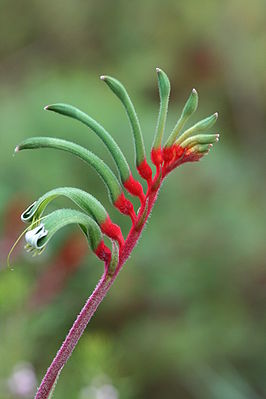
|
||||||||||||
| Systematics | ||||||||||||
|
||||||||||||
| Scientific name | ||||||||||||
| Haemodoraceae | ||||||||||||
| R.Br. | ||||||||||||
| Subfamilies | ||||||||||||
|
The Haemodoraceae are a family of plants in the order of the Commelina-like (Commelinales) within the monocotyledons . Many varieties of the kangaroo flower ( Anigozanthos flavidus ) are used as ornamental plants .
description

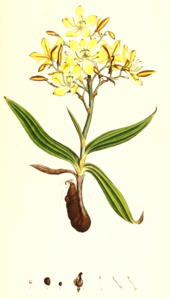

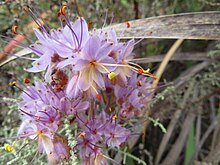

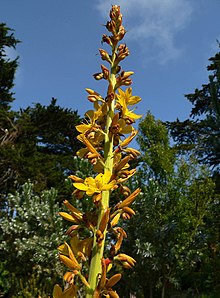


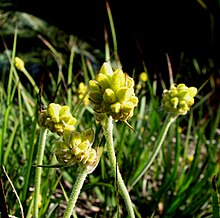

Appearance and leaves
The species of Haemodoraceae are perennial herbaceous plants . They often contain a colored (orange to red) juice. They mostly form underground storage organs : tubers or rhizomes . The tissues of the underground plant parts are often pigmented bright red. In Haemodorum , pigmentation is present in the tissues of the whole plant. The stems are unbranched.
The leaves are alternately arranged mostly directly above the ground in a rosette-like manner or in two rows on the stem. The sessile, simple leaves are more or less linear, leathery, have parallel veins and have entire margins. Some taxa have xeromorphic leaves. The stomata are paracytic.
Inflorescences and flowers
The flowers are individually or mostly in zymose or racemose inflorescences together.
The hermaphrodite flowers are threefold and mostly zygomorphic , rarely radial symmetry . They have identical bloom cladding sheets . In the subfamily Haemodoroideae, the bracts are free and there are two bract circles, i.e. six tepals per flower. In the subfamily Conostyloideae, the bracts are fused into a tube and there is only one bract circle, i.e. three tepals per flower. The colors of the bracts range from white to green and from yellow to orange to red and even almost black. The bracts are hairy more or less intensely on the outside. There are one or two circles per flower, each with three unequal stamens . In Pyrrorhiza and Schiekia there are two staminodes . The three carpels are an upper to under constant ovary fused with one to 50 ovules per ovary chamber. The original three parts of the stylus are partly free to completely grown together. There are septal nectaries .
Fruits and seeds
There are fruit capsules , schizocarps or nut fruits formed. The seeds containing starch are mostly wingless or winged in Haemodorum ; they can be smooth or hairy.
Ingredients and chromosome numbers
Calcium oxalate crystals are often stored as raphids. It contains flavonols: Kaempferol ( Anigozanthos and Haemodorum ) and Quercetin ( Haemodorum ). The basic chromosome numbers are x = 4 to 8, or 12, 15, 19 to 21.
ecology
The pollination is carried out by a variety of different animals: insects ( Conostylis of bee species; Entomophilie ), birds (Australian Anigozanthos , Blancoa , Macropidia are pollinated by honey birds; ornithophily ) or in some species by small mammals .
The only species of Australian butterfly (Lepidoptera) that have been reported to feed on Haemodoraceae is Motasingha trimaculata .
Systematics and distribution
Taxa of this family thrive from the tropics to the warm temperate latitudes . A main area of distribution is Australia . Taxa are also native to the Capensis , New Guinea , the southeastern USA, Central America and tropical South America.
The family name Haemodoraceae was first published in 1810 by Robert Brown in Prodromus Florae Novae Hollandiae , 299. The type genus is Haemodorum Sm. Synonyms for Haemodoraceae R.Br. are: Conostylidaceae Takht. , Wachendorfiaceae Herb. , Xiphidiaceae Dumort.
The Haemodoraceae and Pontederiaceae are sister groups and to these two families Philydraceae is a sister group within the order of the Commelinales .
The Haemodoraceae family is divided into two subfamilies with 14 genera and contains 108 to 116 species:
- Subfamily Haemodoroideae: There is only one circle with three fertile stamens. It contains about eight genera with about 39 species:
-
Barberetta Harv. : It contains only one type:
- Barberetta aurea Harv. : It occurs in the South African provinces of Eastern Cape and KwaZulu-Natal .
- Dilatris P.J.Bergius : The four species occur only in the Capensis .
- Haemodorum Sm .: The 27 species since 2015 are mainly distributed throughout Australia and Tasmania , and also in New Guinea .
-
Lachnanthes Elliott (Syn .: Anonymos Walter nom. Rej., Camderia Dumort. Nom. Superfl., Gyrotheca Salisb. Nom. Superfl., Heritiera J.F. Gmel . Nom. Illeg.): It contains only one species:
- Lachnanthes caroliniana (Lam.) Dandy : It is common in eastern North America from Canada to the United States and in western Cuba, small Caribbean islands and islands off Honduras.
-
Pyrrorhiza Maguire & Wurdack : It contains only one species:
- Pyrrorhiza neblinae Maguire & Wurdack : It is endemic to the Pico da Neblina in southern Venezuela .
-
Schiekia Meisn. (Syn .: Troschelia Klotzsch & MRSchomb. ): It contains only one species:
- Schiekia orinocensis (Kunth) Meisn. : It is distributed with two subspecies in tropical South America.
- Wachendorfia Burm. (Syn .: Pedilonia C.Presl ): The approximately four species occur in the Capensis.
-
Xiphidium Aubl. : It contains only two types:
- Xiphidium caeruleum Aubl. : It iswidespreadfrom central Mexico through Central America and on Caribbean islands to tropical South America.
- Xiphidium xanthorrhizon C. Wright ex Griseb. : This endemic occurs only in western Cuba and on Isla de la Juventud .
-
Barberetta Harv. : It contains only one type:
- Subfamily Conostyloideae (Lindl.) TDMacfarl. & Hopper : Here the underground parts of the plant are not pigmented red. There are two circles with three fertile stamens each. It is divided into two tribes with six genera and about 77 species only in the southwestern part of the Australian state of Western Australia.
- Tribe Conostylideae Lindl. : It contains five genera:
- Kangaroo flowers , also called kangaroo paws, ( Anigozanthos Labill. , Syn .: Anigosia Salisb. , Schwaegrichenia Spreng. ): The eleven to twelve species occur only in southwestern Western Australia .
-
Blancoa Lindl. : It contains only one type:
- Blancoa canescens : This endemic occurs only in southwestern Western Australia.
- Conostylis R.Br. (Syn .: Androstemma Lindl. ): The 45 to 46 species occur only in southwestern Western Australia.
-
Macropidia J. Drumm . ex Harv. : It contains only one type:
- Macropidia fuliginosa (Hook.) Druce (Syn .: Anigozanthos fuliginosus Hook. ): This endemic occurs only in southwestern Western Australia.
- Phlebocarya R.Br. : The three species are only found in southwestern Western Australia.
- Tribus Tribonantheae TDMacfarl. & Hopper : It contains only one genus:
- Tribonanthes Endl. : Since 2006 there are about six species only in southwestern Western Australia.
- Tribe Conostylideae Lindl. : It contains five genera:
No longer in this family Haemodoraceae, but:
- to the butcher's broom plants include (Ruscaceae):
- Liriope Lour.
- Ophiopogon Ker Gawler
- belong to the Nartheciaceae :
- Aletris L.
-
Lophiola Ker Gawler : It contains only one species:
- Lophiola aurea Ker Gawler : It is common in North America.
use
The kangaroo flower ( Anigozanthos flavidus ) with its many varieties is a widespread ornamental plant for parks and gardens, and has recently also been used as an exotic houseplant . But other genera also contain species that are used as ornamental plants.
The Aborigines mainly used the underground parts of the plant, mostly roasted, as food. A red pigment can be obtained from Haemodorum .
Lachnanthes carolina was by the natives as noise drug used. A red dye can be obtained from the underground parts of the plant. Medical effects were examined.
swell
- The family of Haemodoraceae in APWebsite. (Sections systematics and description)
- The Haemodoraceae family at DELTA by L. Watson and MJDallwitz. (Section description)
- TD Macfarlane, Stephen D. Hopper, RW Purdie, AS George, SJ Patrick: Haemodoraceae. In: Flora of Australia , Volume 45, 1987: online.
- The Haemodoraceae family in Western Australian Flora . (Section description)
- Kenneth R. Robertson: Haemodoraceae. P. 47 - same text online as printed work , In: Flora of North America Editorial Committee (Ed.): Flora of North America North of Mexico. Volume 26: Magnoliophyta: Liliidae: Liliales and Orchidales , Oxford University Press, New York and Oxford, 2002. ISBN 0-19-515208-5 (section description)
- Stephen D. Hopper, Michael F. Fay, M. Rossetto, Mark W. Chase: A molecular phylogenetic analysis of the bloodroot and kangaroo paw family, Haemodoraceae: taxonomic, biogeographic and conservation implications. In: Botanical Journal of the Linnean Society , Volume 131, Issue 3, 1999, pp. 285-299. doi: 10.1111 / j.1095-8339.1999.tb00770.x .
- WS Judd, CS Campbell, EA Kellogg, PF Stevens, MJ Donoghue: Haemodoraceae , In: Plant Systematics: A Phylogenetic Approach , 3rd Edition, Sinauer Associates, 2007, p. 283. ISBN 978-0-87893-407-2 .
- Stephen D. Hopper, Rhian J. Smith, Michael F. Fay, John C. Manning, Mark W. Chase: Molecular phylogenetics of Haemodoraceae in the Greater Cape and Southwest Australian Floristic Regions. In: Molecular Phylogenetics and Evolution , Volume 51, Issue 1, 2009, pp. 19-30. doi: 10.1016 / j.ympev.2008.11.015 .
- Paul JM Maas, Hiltje Maas-van de Kamer, 2009: Neotropical Haemodoraceae at Neotropikey - Interactive key and information resources for flowering plants of the Neotropics .
- Layla Aerne-Hains, Michael G. Simpson: Vegetative Anatomy of the Haemodoraceae and Its Phylogenetic Significance. In: International Journal of Plant Sciences , Volume 178, Issue 2, February 2017, pp. 117–156. doi: 10.1086 / 689199 .
Individual evidence
- ↑ Don Herbison-Evans, Christine Ashe: Haemodoraceae in Australia : data sheet at australian-insects.com . ( Memento of the original from December 16, 2009 in the Internet Archive ) Info: The archive link was inserted automatically and has not yet been checked. Please check the original and archive link according to the instructions and then remove this notice.
- ↑ a b data sheet - Haemodoraceae at Australian Plant Name Index = APNI.
- ^ Haemodoraceae at Tropicos.org. Missouri Botanical Garden, St. Louis
- ^ A b Haemodoraceae in the Germplasm Resources Information Network (GRIN), USDA , ARS , National Genetic Resources Program. National Germplasm Resources Laboratory, Beltsville, Maryland.
- ↑ a b c d e f g h i j k l m n o p q r s Rafaël Govaerts (ed.): Haemodoraceae. In: World Checklist of Selected Plant Families (WCSP) - The Board of Trustees of the Royal Botanic Gardens, Kew . Retrieved February 24, 2018.
- ^ John C. Manning, Peter Goldblatt: A review of Dilatris PJBergius (Haemodoraceae: Haemodoroideae). In: South African Journal of Botany , Volume 113, November 2017, pp. 103-110. doi: 10.1016 / j.sajb.2017.08.001
- ↑ Paul JM Maas, Hiltje Maas-van de Kamer, 2009: Neotropical Haemodoraceae at Neotropikey - Interactive key and information resources for flowering plants of the Neotropics .
- ↑ Lachnanthes carolina at Plants For A Future
